How Mayor-Elect Brandon Johnson Sold Chicago On ‘Investing In People’
- Oops!Something went wrong.Please try again later.
- Oops!Something went wrong.Please try again later.
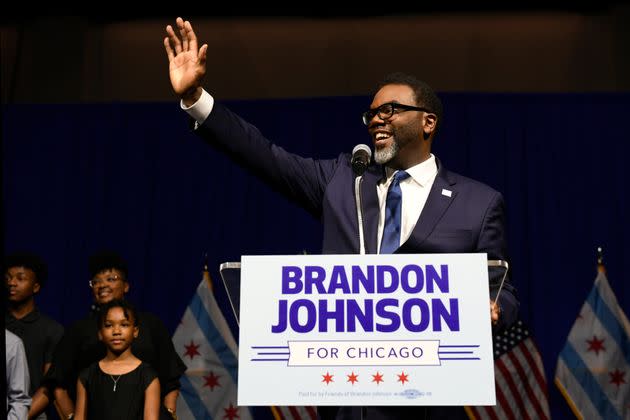
Chicago Mayor-elect Brandon Johnson celebrates with supporters after defeating Paul Vallas late Tuesday in Chicago.
The end of the Chicago mayoral runoff was two weeks away and Ray Lopez, a Chicago City Council member backing Paul Vallas, was worried.
Among other complaints, the alderman fretted that Vallas’ progressive rival, Brandon Johnson, was “winning the emotional war” with a more uplifting message.
“We need a warm and fuzzy Vallas, not a harbinger of doom,” Lopez, a conservative Democrat, told HuffPost in a March 21 phone conversation.
Barring major changes in the race’s dynamics, his prognosis was negative. “Vallas is going to lose,” he predicted.
Those fears proved correct. After being outspent by 2 to 1 on TV, Johnson, a Cook County commissioner and organizer for the Chicago Teachers Union, defeated Vallas, a former CEO of Chicago Public Schools, on Tuesday, defying public polling that consistently showed Vallas ahead.
As of Monday, with valid mail-in ballots still trickling in, Johnson’s lead over Vallas had surpassed 4 percentage points.
Given the uptick in violent crime gripping Chicago, and the city’s continued struggle to recover from the economic fallout of the COVID-19 pandemic, the triumph of a left-wing figure like Johnson is a major political feat.
Johnson and his campaign achieved this outcome thanks to a monthslong plan to introduce him to the public, claim the public-safety mantle from the left, consolidate support among Black voters, target voters with digital media advertisements, and discredit Vallas as a Republican with a record of failure.
“I don’t think Vallas did wrong as much as Brandon did right,” said Frank Calabrese, a Chicago-based Democratic data scientist and pollster who was unaligned in the race.
Johnson also benefited from his opposing candidate being Vallas, whose wonkish speaking style contrasted strongly with Johnson’s charisma and whose dalliances with the hard right were hard to shake off.
The latter was especially costly in a heavily Democratic city where President Joe Biden received nearly 83% of the vote, including a majority in all 50 City Council wards.
“The ‘Republican’ attacks were just too much to overcome,” said a senior official on Vallas’ campaign who requested anonymity to speak freely.
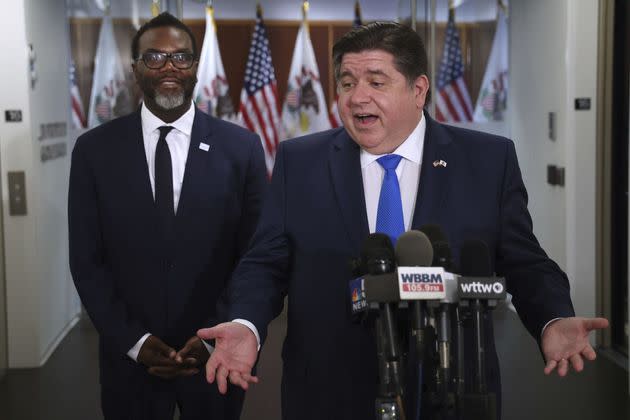
Johnson (left) and Democratic Illinois Gov. J.B. Pritzker speak to the media after meeting on Friday. Pritzker, who was officially neutral in the race, had been criticized by Vallas.
‘Brandon Is Better’
As a testament to how far he’s come, Johnson is fond of noting that he started his mayoral campaign with 2% support in the polls.
But the biggest barrier to raising that number was Johnson’s low level of name recognition. It’s much harder to support someone, after all, if you don’t know who they are.
Under the direction of ad-maker Brandon Davis, Johnson’s campaign decided that his first TV spot, in late December, would be just 15 seconds long. The narrator of the spot informs Chicagoans about Johnson’s plan to make “Chicago safer,” create jobs, and improve public schools, concluding with the tagline, “For mayor, Brandon Johnson is better for Chicago,” as the words “Brandon is better” appear on screen.
Most political TV ads are 30 seconds long, prompting some Democratic operatives to question the decision. But the brevity of the spot allowed the Johnson campaign to ensure that it aired on broadcast TV more frequently each day, drilling Johnson’s name into voters’ heads.
In a second, 30-second TV ad in January, the campaign used the same “Brandon is better” frame to raise awareness of the work he did on the county commission expanding health care, investing in violence prevention programs, and preventing housing discrimination.
Davis told HuffPost that the “Brandon is better” frame was designed to capitalize on Mayor Lori Lightfoot’s unpopularity and present an alternative to dissatisfied voters.
“We knew that, particularly in the general election, this was a ‘change’ electorate — an electorate that wanted something different,” Davis said.
Chicago held citywide, nonpartisan elections on Feb. 28 in which Johnson was competing with eight other candidates, including Vallas, Lightfoot, and U.S. Rep. Jesús “Chuy” García. Assuming, as polls anticipated, none of the candidates received an outright majority in that first round, the top two finishers would participate in a runoff on April 4.
Although Lightfoot was openly dismissive of Johnson’s candidacy, Johnson’s team paced its advertising and messaging with an eye toward a runoff contest against Vallas, who consistently polled in first place.
The campaign planned to use “15 weeks to tell that story consistently and hit benchmarks that would get us into the runoff and ultimately deliver if we’re in the runoff,” Davis said.
Either you’re going to say we’re too radical and we have too many taxes, or you’re going to say we have no experience, we have no plan and we’re not up to the job, but you can’t say both.Jason Lee, senior adviser for the Johnson campaign
With that in mind, the campaign set out early on to have Johnson begin inoculating himself from charges that he was soft on crime. At every available opportunity, Johnson emphasized that the issue of violent crime was personal for him, because he and his wife were raising their three kids in Austin, an impoverished neighborhood on Chicago’s West Side where crime is rampant.
“No one has a greater incentive in this race for our city to be better, stronger and safer than someone who is living the daily experience of working- and middle-class families all over the city of Chicago,” Johnson told HuffPost in an interview in February.
While Johnson had spearheaded a nonbinding resolution in 2020 for Cook County to transfer some law enforcement funds to social programs and had spoken positively about the “defund the police” movement, his public safety plan proposed keeping Chicago Police Department funding where it is. He would instead find ways to make department spending more efficient and use the extra funds to add 200 detectives to the force through internal promotion. He also promised to reopen shuttered public mental health clinics, and double the city’s summer youth employment program such that it would provide 60,000 jobs.
In keeping with his mantra of “investing in people,” Johnson unveiled a budget plan that listed ways to pay for his ambitious agenda. The move was unorthodox, because it included a list of taxes that Johnson planned to raise on high earners and big businesses, including mansion owners, airlines and hotels.
But notably, raising additional revenue elsewhere allowed him to promise that he would not increase the city’s property taxes, which are by far the most politically radioactive fiscal issue in Chicago politics. And the budget plan had the added benefit of enabling Johnson to portray himself as more serious than Vallas, who did not present a proposal with a comparable level of detail.
“We forced a decision point,” recalled Jason Lee, a senior adviser to Johnson’s campaign. “Either you’re going to say we’re too radical and we have too many taxes, or you’re going to say we have no experience, we have no plan and we’re not up to the job, but you can’t say both.”
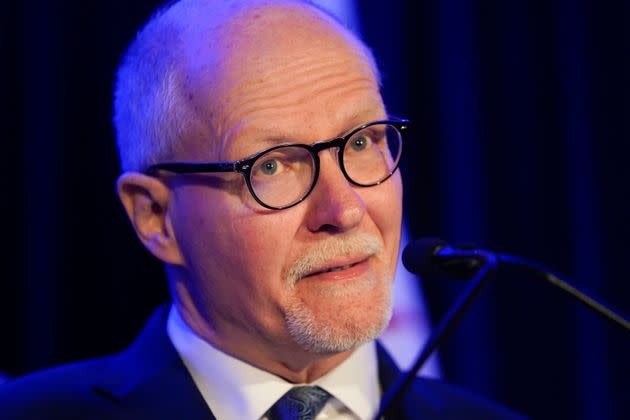
Vallas addresses his supporters after conceding the runoff election on Tuesday. He was unable to allay voter fears about conservative comments he had made over the years.
Defining Vallas
Johnson began defining Vallas as a Republican who failed public-school families and pensioners from the moment he made the runoff on Feb. 28. In his speech celebrating his entry into the runoff, Johnson alleged that Vallas is “someone who is supported by the Jan. 6 insurrectionists,” presumably referring to John Catanzara, the president of Chicago’s Fraternal Order of Police (FOP) who downplayed the riot at the U.S. Capitol on Jan. 6, 2021. (The FOP endorsed Vallas in January.)
“He switched parties when Barack Obama became president of the United States,” Johnson continued. “He went as far as to say that he is more of a Republican than anything else. These are his words.”
Johnson did not let up. In his March 8 debate with Vallas, the first televised showdown of the runoff, Johnson accused Vallas of being a Republican or a Republican sympathizer at least seven times. Vallas, whose ads always described him as a “lifelong Democrat,” noted that he had been the Democratic nominee for lieutenant governor of Illinois in 2014, but mostly refrained from putting Johnson on the defensive with attacks of his own. Johnson’s past support for the “defund the police” movement came up only in the context of a moderator question and answer from Johnson.
Indeed, the better-funded Vallas campaign took its time before going on the offensive against Johnson. The Vallas campaign’s first two TV ads of the runoff election were positive spots touting former Illinois Secretary of State Jesse White’s endorsement and former President Bill Clinton’s praise for Vallas’ work as head of Chicago public schools.
By the time Vallas began attacking Johnson for his past sympathy for “defund the police,” though, Johnson was defining himself with a 15-second spot outlining his plans to beef up mental health care and youth jobs as a crime prevention strategy.
“Maybe he should have tried to define us earlier,” Lee, the Johnson adviser, said. “[The delay] allowed us to get back up and inoculate ourselves.”
Brandon has shown us that if you have an adult conversation with voters about crime, voters understand that poverty is the root cause of crime.Karthik Ganapathy, strategic consultant for the Johnson campaign
The Vallas campaign considered going negative from the start of the runoff, according to a second senior aide on Vallas’ team. The team felt, however, that those first two ads were necessary to inoculate Vallas against charges that he was not a real Democrat, according to that aide.
At the same time, Johnson’s campaign was confident that his belief in what Lee called a “nuanced” approach to public safety — one that emphasized tackling root causes as well as solving cases — was popular.
A public poll released the day before the April 4 runoff supported this view of public opinion. A majority of Chicago voters polled said they preferred a prevention-first approach to crime that prioritized improving people’s living standards and mental health care, as opposed to imposing tougher sentences and providing more resources to the police.
“Brandon has solved a big problem for Democrats, which is that we have been stuck in this defensive posture when it comes to ‘defund.’ Republicans hit us with it, we feel the need to just overcorrect and say we’re gonna invest a trillion more dollars in police and put them all over the place,” said Karthik Ganapathy, a strategic consultant for the Johnson campaign. “Brandon has shown us that if you have an adult conversation with voters about crime, voters understand that poverty is the root cause of crime.”
For a more conservative candidate backed by the police union, Vallas had his own relatively liberal positions on police reform. He touted his work negotiating new accountability measures in the Chicago Police Department’s newest collective bargaining agreement, and promised to end no-knock warrants, expedite implementation of the Department of Justice’s consent decree with the police force, and fund non-police violence prevention programs of the kind launched by the Rev. Corey Brooks, a South Side pastor and Vallas supporter.
That message might have been lost on Chicago voters given Vallas’ emphasis on hiring more cops, his criticism of Johnson for refusing to commit to the same, and his allegations that Johnson would “defund” the city’s police force.
The Johnson campaign also believes Johnson benefited from Republicans’ over-reliance on “defund the police” accusations against Democrats, including mainstream Democrats against whom the charge was not remotely credible. As a result, many Democratic voters were jaded about the allegation and more likely to see it as a partisan attack, according to Bill Neidhardt, Ganapathy’s business partner and fellow Johnson adviser.
“The ‘defund’ attack against Democrats has jumped the shark,” Neidhardt said. “When we made this race into Republican versus Democrat, every ‘defund’ ad against Brandon … became ‘They’re attacking him because he’s a Democrat.’”
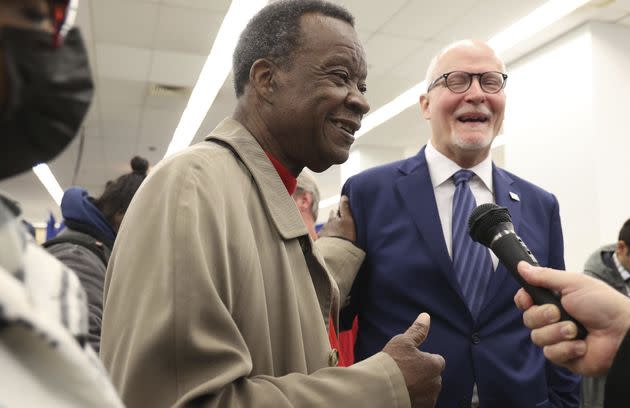
Mayoral candidates Willie Wilson (left) and Vallas talk before filing petition signatures on Nov. 21, 2022. Wilson’s endorsement of Vallas in the runoff was one of several that failed to deliver a significant number of votes for Vallas.
Vallas’ Shortcomings
Of course, a campaign is inherently boxed in by the strengths and weaknesses a candidate brings to the table.
Vallas, who fell short in his bid for the Democratic gubernatorial nomination in 2002 and got crushed in his 2019 mayoral run, underwent strenuous media training that improved his message discipline this time around and made him more comfortable speaking about his personal history.
Vallas even filmed a TV ad in which he spoke directly to camera about how his childhood years in the South Side neighborhood of Roseland and the loss of his son to drug addiction informed his view of the challenges shaping working-class Chicagoans.
But Vallas never fully shed his technocratic speaking style, which made for an unflattering contrast with Johnson, who has a preacherly cadence and a penchant for digestible sound bites, such as his aspiration to build a “better, stronger, safer Chicago.”
Even when discussing an issue as emotional and central to his candidacy as public safety, Vallas often reverted to rattling off statistics — the numbers of 911 calls unanswered, the outstanding arrest warrants, the shortage of shelter beds for domestic violence survivors.
“He would have been a great mayor,” the senior Vallas campaign operative said. “I guess he would have been a better mayor than he was a candidate.”
Vallas also made mistakes before his run for mayor that would have been very difficult for any campaign to correct.
In 2009, Vallas entertained a run for the Cook County Board of Commissioners as a Republican. He decided against the plan, and now says that he was only considering Republican affiliation because he wanted to be independent of the entrenched Democratic machine.
But before Vallas ended his flirtation with a Republican run for office, he conducted a half-hour interview with conservative TV host Jeff Berkowitz in which he said he was “more of a Republican than a Democrat now.” The interview also featured a convoluted exchange in which Vallas said he supported abortion rights but was personally against abortion, stating, “Fundamentally, I oppose abortion.”
The footage, which had already surfaced briefly during Vallas’ run for lieutenant governor, was “devastating” to Vallas’ 2023 mayoral bid, according to the senior Vallas campaign operative.
But the appearance also dated to a less-polarized period when moderate Republicans were still a factor in Chicago-area politics.
Vallas’ decision during the COVID-19 pandemic to become a regular guest host on a variety of conservative talk radio shows was much harder to justify in retrospect. The hours of conversation he recorded on those shows included comments deriding President Joe Biden, former President Barack Obama, and Illinois Gov. J.B. Pritzker (D); suggesting there was too much focus on Black history in schools; and likening congressional Democrats’ January 2021 impeachment of then-President Donald Trump to a “witch hunt.”
Taken in context, Vallas often sounded more like a Democrat trying to give conservative arguments their due, but his mere presence on those shows made for audio — and sometimes video footage — that inflicted lasting political damage.
I don’t understand why he was on conservative talk radio two years ago. That’s just not what Democrats do.Frank Calabrese, Democratic strategist
“I don’t understand why he was on conservative talk radio two years ago,” said Calabrese, the non-aligned Democratic strategist. “That’s just not what Democrats do.”
Absent those appearances, Vallas would still have gotten the city’s conservative vote, Calabrese added, because he was “sympathetic to the police, endorsed by the Fraternal Order of Police, and all that stuff. He didn’t have to do all this right-wing media.”
The Johnson campaign made sure news outlets reported on those comments, brought them up in debates, and included them in an array of TV and digital ads.
In addition, Johnson succeeded in making what might have, in a different era, been an asset for Vallas into something of a liability: his decades as a “school choice”-oriented, public schools superintendent in economically distressed cities. Vallas’ work in Philadelphia, New Orleans, and Bridgeport, Connecticut, though deeply controversial, won its share of praise from local stakeholders.
Regardless of their merits, the very nature of Vallas’ reforms — shuttering some neighborhood schools, allowing charter schools to proliferate and initiating changes that led to the ouster of many Black workers — was disruptive. His choices often prompted fierce resistance from unions, elected officials and parents, many of whom were willing to publicize their issues with Vallas in the course of the mayoral campaign.
Once again flouting campaign advertising conventions, the Johnson campaign aired a two-minute TV spot, “Trail of Destruction,” in the final three days of the campaign that featured Black public-school parents from New Orleans and Philadelphia lamenting Vallas’ stewardship of the school systems in their cities and warning against electing him in Chicago. The ad promoted a custom website, wrongforchicago.com, that informed readers in large red font of all the reasons Vallas was a “Republican whose policies help wealthy donors and hurt working families.”
“Even the mismanagement stuff, we could link that to being a Republican too — privatizing schools in New Orleans, laying off teachers and arresting kindergarteners,” said Lee, likely referring to the surge in suspensions, not arrests, of kindergarteners in Philadelphia during Vallas’ tenure.
To communicate all of these elements of Johnson’s message, Johnson’s campaign spent one-third of its advertising budget on digital ads. Digital advertising — on social media, YouTube, and video-streaming platforms like Amazon Prime — enabled the campaign to target voters by age, geography and voting history. No such targeting is available on television, which made Vallas’ heavy reliance on TV less efficient and undermined the impact of his 2-to-1 spending edge on that medium.
“They relied on an old notion of ‘scare people and be as loud as you can on broadcast television,’” said Davis, Johnson’s advertising consultant. “That missed the boat with where people really were.”
The two Vallas campaign officials with whom HuffPost spoke did not have an estimate handy of how much of Vallas’ advertising budget was spent online, but they maintained it was substantial.
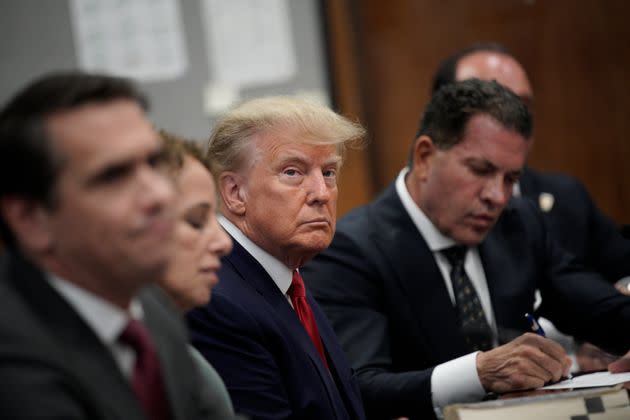
Former President Donald Trump's arraignment coincided with Election Day in Chicago, which Vallas' aides believe strengthened Johnson's hand.
Building The Winning Coalition
When Johnson made it to the runoff, it was clear that as the sole Black candidate in the race, he would outperform Vallas in the majority-Black precincts that had voted for Lightfoot and other Black candidates in the first round of the election.
The open question was by how much Johnson would win those precincts. Vallas made a real play for voters in predominantly Black neighborhoods on the South and West sides, landing the endorsements of prominent Black leaders, including Jesse White, former U.S. Rep. Bobby Rush (D), businessman Willie Wilson, and an array of Black Chicago City Council members and pastors. The hope was that older, more conservative Black voters would seriously consider Vallas and enable him to secure a respectable one-third of the Black electorate.
Vallas even unsuccessfully sought Mayor Lightfoot’s blessing, while Johnson declined to reach out, according to someone close to Lightfoot.
For his part, Johnson had a long-standing relationship with the Rev. Jesse Jackson Sr. and his son U.S. Rep. Jonathan Jackson (D). That friendship made it easier for Johnson to connect with House Democratic Whip Jim Clyburn (D-S.C.) during Johnson’s visit to Selma, Alabama, for the annual commemoration of the “Bloody Sunday” voting rights demonstration in early March. Clyburn would go on to endorse Johnson, lending him mainstream credibility from a top national Democrat and Black leader.
As it turned out, Johnson won majority-Black precincts with more than 80% of the vote. Both campaigns believe endorsements played less of a role in that outcome than the sheer fact of Johnson’s presence on the ballot and the campaign’s success in informing Black voters who he was.
Johnson’s sweep of the Black vote, in spite of Vallas’ endorsements from Black Chicago City Council members with well-regarded turnout operations, is an “indictment of the old-school Chicago machine,” revealing how little power council members have to sway voters, said Calabrese, the Democratic strategist.
Vallas had his own field program that helped him drive up support from his base during the early voting period. And once he was in the runoff, his team merged their field operations with the turnout and canvassing apparatus of the transportation and building trades unions that had endorsed his bid.
The monthslong support that Johnson received from the Chicago Teachers Union and the Service Employees International Union likely gave his field operation a head start, however. Both unions are also better known for their electioneering and worker organizing than other, more moderate unions.
“They have the best organizers in the whole country,” Calabrese said.
The impact of Johnson’s field organization was perhaps most apparent in the substantial increase in young voter turnout that Johnson engineered. The number of voters aged 18 to 24 increased by 15.5% from the first round of the election to the runoff, while the number of voters aged 75 and older decreased by 13.5%, according to a WBEZ analysis.
Geographically, Johnson’s strong performance in the highly educated and high-earning lakefront neighborhoods north of downtown Chicago likely put him over the top.
I just don’t think that there was any real, effective response to that, especially in this environment today where politics is polarized.Senior official on the Vallas campaign
Johnson’s improvement in the 44th Ward, which includes the North Side neighborhoods of Lakeview and Wrigleyville, was emblematic. In the first round of the election, Vallas had won the ward with about 41% of the vote, compared with about 31% for Johnson. In the runoff, Johnson won the ward with more than 51% of the vote, compared with under 49% for Vallas — a result that closely mirrored Johnson’s citywide margin.
Many of those so-called lakefront liberal voters have a fiscally conservative streak, but they are solid Democrats, and for enough of them, there were real questions about whether Vallas aligned with their fundamental values.
“I just don’t think that there was any real, effective response to that, especially in this environment today where politics is polarized,” the senior official on the Vallas campaign said.
Meanwhile, new tidbits kept emerging that fed Johnson’s narrative about Vallas. Catanzara, who was reelected president of the police union in early March, told The New York Times days before the runoff that a Johnson mayoralty would mean “blood in the streets.”
Then, the polarizing effect of Trump’s indictment on March 30 was the nail in the coffin for Vallas, both Vallas campaign sources told HuffPost.
At the risk of alienating his most conservative supporters, Vallas immediately applauded the news, calling it a chance to show that “no one is above the law” and affirming that Trump “must be held accountable” for his actions.
But Johnson used the occasion to remind voters in a TV ad that Vallas had once called Democrats’ impeachment proceedings against Trump a “witch hunt.” (Vallas had instead called for Congress to censure Trump, arguing that such a move would have “put much more pressure” on Republicans in Congress.)
It didn’t help matters for Vallas that Trump’s arraignment took place on Election Day in Chicago, heightening the salience of partisanship in a race where it was a losing issue for Vallas.
“The ‘Trump witch hunt’ ad was probably one of the deciding factors pushing undecided lakefront liberals toward Johnson more solidly,” the second senior Vallas campaign aide told HuffPost. “That was probably the difference.”
